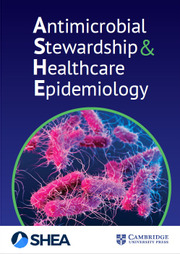Crossref Citations
This article has been cited by the following publications. This list is generated based on data provided by
Crossref.
Lakoh, Sulaiman
Yi, Le
Russell, James B.W.
Zhang, Juling
Sevalie, Stephen
Zhao, Yongkun
Kanu, Joseph Sam
Liu, Peng
Conteh, Sarah K.
Williams, Christine Ellen Elleanor
Barrie, Umu
Sheku, Mohamed Gbessay
Jalloh, Mohamed Boie
Adekanmbi, Olukemi
Jiba, Darlinda F.
Kamara, Matilda N.
Deen, Gibrilla F.
Okeibunor, Joseph Chukwudi
Yendewa, George A.
Guo, Xuejun
and
Firima, Emmanuel
2022.
The burden of surgical site infections and related antibiotic resistance in two geographic regions of Sierra Leone: a prospective study.
Therapeutic Advances in Infectious Disease,
Vol. 9,
Issue. ,
Lakoh, Sulaiman
John-Cole, Valerie
Luke, Ronita D.C.
Bell, Nellie
Russell, James B.W.
Mustapha, Ayeshatu
Barrie, Umu
Abiri, Onome T.
Coker, Joshua M.
Kamara, Matilda N.
Coker, Freddie J.
Adekanmbi, Olukemi
Kamara, Ibrahim Franklyn
Fofanah, Bobson Derrick
Jiba, Darlinda F.
Adeniji, Adetunji O.
Kenneh, Sartie
Deen, Gibrilla F.
Moon, Troy D.
Yendewa, George A.
and
Firima, Emmanuel
2023.
Antibiotic use and consumption in Freetown, Sierra Leone: A baseline report of prescription stewardship in outpatient clinics of three tertiary hospitals.
IJID Regions,
Vol. 7,
Issue. ,
p.
43.
Lakoh, Sulaiman
Williams, Christine Ellen Elleanor
Sevalie, Stephen
Russell, James B.W.
Conteh, Sarah K.
Kanu, Joseph Sam
Barrie, Umu
Deen, Gibrilla F.
Maruta, Anna
Sesay, Daniel
Adekanmbi, Olukemi
Jiba, Darlinda F.
Okeibunor, Joseph Chukwudi
Yendewa, George A.
and
Firima, Emmanuel
2023.
Antibiotic use and consumption among medical patients of two hospitals in Sierra Leone: a descriptive report.
BMC Infectious Diseases,
Vol. 23,
Issue. 1,
Lakoh, Sulaiman
Yi, Le
Russell, James B.W.
Zhang, Juling
Sevalie, Stephen
Zhao, Yongkun
Kanu, Joseph Sam
Liu, Peng
Conteh, Sarah K.
Williams, Christine Ellen Elleanor
Barrie, Umu
Adekanmbi, Olukemi
Jiba, Darlinda F.
Kamara, Matilda N.
Sesay, Daniel
Deen, Gibrilla F.
Okeibunor, Joseph Chukwudi
Yendewa, George A.
Guo, Xuejun
and
Firima, Emmanuel
2023.
High incidence of catheter-associated urinary tract infections and related antibiotic resistance in two hospitals of different geographic regions of Sierra Leone: a prospective cohort study.
BMC Research Notes,
Vol. 16,
Issue. 1,
Lakoh, Sulaiman
Bawoh, Mohamed
Lewis, Hannah
Jalloh, Ishmael
Thomas, Catherine
Barlatt, Shuwary
Jalloh, Abdulai
Deen, Gibrilla F.
Russell, James B. W.
Kabba, Mustapha S.
Batema, Moses N. P.
Borgstein, Cecily
Sesay, Noah
Sesay, Daniel
Nagi, Navjeet K.
Firima, Emmanuel
and
Thomas, Suzanne
2023.
Establishing an Antimicrobial Stewardship Program in Sierra Leone: A Report of the Experience of a Low-Income Country in West Africa.
Antibiotics,
Vol. 12,
Issue. 3,
p.
424.
Kpagoi, Satta Sylvia Theresa Kumba
Kamara, Kadijatu Nabie
Carshon-Marsh, Ronald
Delamou, Alexandre
Manzi, Marcel
Kamara, Rugiatu Z.
Moiwo, Matilda Mattu
Kamara, Matilda
Koroma, Zikan
Lakoh, Sulaiman
Fofanah, Bobson Derrick
Kamara, Ibrahim Franklyn
Kanu, Alex Bumble John
Kenneh, Sartie
Kanu, Joseph Sam
Margao, Senesie
and
Kamau, Edward Mberu
2023.
Assessing Changes in Surgical Site Infections and Antibiotic Use among Caesarean Section and Herniorrhaphy Patients at a Regional Hospital in Sierra Leone Following Operational Research in 2021.
Tropical Medicine and Infectious Disease,
Vol. 8,
Issue. 8,
p.
385.
Kamara, Ibrahim Franklyn
Kanu, Joseph
Maruta, Anna
Fofanah, Bobson Derrick
Kamara, Kadijatu Nabie
Sheriff, Bockarie
Katawera, Victoria
D'Almeida, Selassi A
Musoke, Robert
Nuwagira, Innocent
Lakoh, Sulaiman
Kamara, Rugiatu Z
Tengbe, Sia Morenike
Mansaray, Abdul Razak
Koroma, Zikan
Thomas, Fawzi
Abiri, Onome T
Koroma, Aminata Tigiedankay
Russell, James Baligeh Walter
Squire, James
and
Vandi, Mohamed Alex
2023.
Antibiotic use among hospitalised patients in Sierra Leone: a national point prevalence survey using the WHO survey methodology.
BMJ Open,
Vol. 13,
Issue. 12,
p.
e078367.
Valladales-Restrepo, Luis Fernando
Oyuela-Gutiérrez, María Camila
Delgado-Araujo, Ana Camila
Sabogal-Ortiz, Alejandra
and
Machado-Alba, Jorge Enrique
2024.
Use of Prophylactic Antibiotics in Hand Surgeries in Colombia.
The Journal of Hand Surgery,
Saleem, Zikria
Sheikh, Samia
Godman, Brian
Haseeb, Abdul
Afzal, Shairyar
Qamar, Muhammad Usman
Imam, Mohammad Tarique
Abuhussain, Safa S Almarzoky
and
Sharland, Mike
2025.
Increasing the use of the WHO AWaRe system in antibiotic surveillance and stewardship programmes in low- and middle-income countries.
JAC-Antimicrobial Resistance,
Vol. 7,
Issue. 2,
Donkor, Eric S.
Osman, Abdul-Halim
Aglomasa, Bill Clinton
Awere-Duodu, Aaron
Odoom, Alex
Opoku-Asare, Bismark
and
Lazarus, Gilbert
2025.
Improving antibiotic utilization in West Africa: enhancing interventions through systematic review and evidence synthesis.
Antimicrobial Resistance & Infection Control,
Vol. 14,
Issue. 1,


